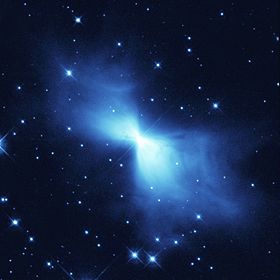The Boomerang Nebula (also called the Bow Tie Nebula) is a protoplanetary nebula[citation needed] located 5,000 light-years away from Earthin the Centaurus constellation. The nebula is measured at 1 K (−272.15 °C; −457.87 °F), the naturally coldest place currently known in the universe.[2] The Boomerang Nebula was formed from the outflow of gas from a star at its core. The gas is moving outwards at a speed of about 164km/s and expanding rapidly as it moves out into space. This expansion is the cause of the nebula's very low temperature.
Keith Taylor and Mike Scarrott called it the 'Boomerang Nebula' in 1980 after observing it with the Anglo-Australian telescope at the Siding Spring Observatory. Unable to view it with the same detail as with theHubble, the astronomers saw merely a slight asymmetry in the nebula's lobes, suggesting a curved shape like a boomerang. The high-resolution Hubble images indicate that the 'Bow Tie Nebula' would perhaps have been a better name.
In 1995, using the 15-metre Swedish ESO Submillimetre Telescope in Chile, astronomers revealed that it is the coldest place in the Universe found so far, besides the laboratory-created Bose-Einstein condensate state of matter. With a temperature of −272 °C, it is only 1 kelvin warmer than absolute zero (the lowest limit for all temperatures). Even the −270 °C background glow from the Big Bang is warmer than the nebula. It is the only object found so far that has a temperature lower than the background radiation. The Boomerang Nebula is also listed as PGC 3074547


No comments:
Post a Comment